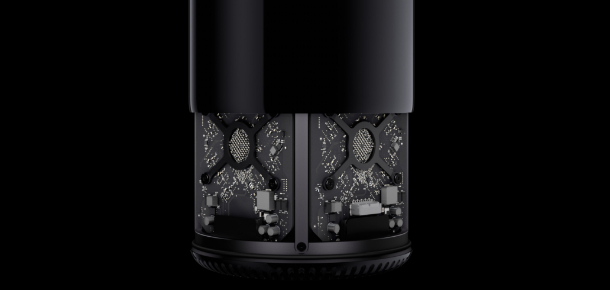As the Mac faithful are aware by now, Apple finally made it official at this week’s World Wide Developers’ Convention (WWDC) that a new Mac Pro workstation is on the way. With a release date no more specific than “this fall” and no estimated pricing released yet, there are plenty of unknowns about the next generation of Apple’s high-end computer.
However, Apple did place an actual machine behind glass for WWDC attendees to get a first-hand look at, and it put some information and photos on its website.
Most immediately striking is the radically new size and shape. The black aluminum cylinder housing the new Mac Pro is only about as tall as the power button on the previous generation of Mac Pro tower. A single fan in the top of the cylinder pulls air up through vents in the bottom. The panel containing all of the connection ports even lights up when a motion sensor detects a user turning the machine to access them. But what’s inside the new machine?
We know it will be powered by Intel’s new Xeon E5 chipset and CPU, with up to 12 core configurations offered. Four channel DDR3 ECC DIMM memory modules are employed, running at 1866Mhz, with room for up for four modules. Currently, that appears to make for a 64 GB memory limit as these modules aren’t sold in capacities larger than 16 GB each. The 64 GB of RAM should be enough for anyone, right?
The hard drive storage consists of a single mini PCIe flash drive that Apple claims is 2.5 times faster than today’s solid-state drive technology. Drive capacity isn’t discussed, but it’s interesting to note that Apple co-founder Steve Wozniak currently works for Fusion IO, a firm working on just this type of mass storage technology. There’s a possibility Fusion IO has at least something to do with the final product. From the flash drive’s appearance in photos, it looks taller than similar existing drives using the mini PCIe socket to connect to a motherboard. This could allow Apple to offer a 1 TB capacity, as opposed to the 512 GB limit seen with others.
Video will be handled by dual AMD FirePro GPUs with up to 6 GB of video memory each, allowing support for up to three simultaneous displays running at up to 4K resolutions. Bluetooth 4.0 support is also included, as is (at least in an optional configuration) the new 802.11ac wireless capability.
Everything else one might want to add to the new Mac Pro must be done externally, because no spare expansion slots are provided, nor is there any unused physical space in the cylinder for extra hardware. Apple generously provides six Thunderbolt 2 ports (a backwards-compatible second generation of the Thunderbolt standard, capable of up to twice the data transfer rate of the original) and four USB 3.0 ports. An HDMI video output and a pair of gigabit ethernet ports round out the collection.
All of this sounds amazing, but it also brings up a few concerns. The first one has to do with the external expansion requirement. Unless Apple also releases a clever expansion box of some sort to go with the machine, the beautiful minimalist cylinder will quickly turn into a can full of tangled cables coming out of it, running to devices which may or may not match the look of the computer. (There’s a good chance that owners will immediately wish to add an external optical drive of some sort, because Apple forgoes one this time around. Many others may wish to add external hard drives.) My second concern is with the pricing. Assuming Apple uses the latest version of the AMD FirePro GPU (the S10000), the current price for a single graphics card for a Windows machine is over $3,000. That price doesn’t come down much if one opts for the previous generation of the FirePro, the S9000. Even if Apple works out a deal with AMD to get discounted pricing, it looks like a pair of these GPUs could add over $5,000 to the price of the machine by themselves.
I’m not sure that many of the self-proclaimed “pro” or “advanced” Mac users out there are ready and willing to pay upwards of $6,000 to $7000 for a new workstation — yet I can’t see a way to get much below that price point while including so much new technology. (Surely, the new PCIe flash storage won’t come very cheap. OCZ’s 512GB PCIe flash drive for Windows PCs sells for $2,378.99 on Amazon at the time I’m writing this!)
I guess we’ll have to wait and see what eventually materializes this fall, but I suspect many of us will wind up doing a lot more waiting (and saving) if we want one occupying our own desks.


Comments are closed.